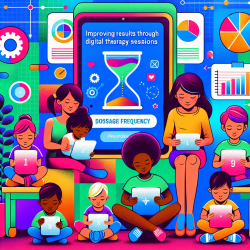In the realm of speech-language pathology, particularly when addressing poststroke aphasia, the frequency of therapy sessions can significantly impact treatment outcomes. The recent study "Dosage Frequency Effects on Treatment Outcomes Following Self-managed Digital Therapy: Retrospective Cohort Study" published in the Journal of Medical Internet Research provides compelling data that underscores this point. By analyzing anonymized data from 2249 poststroke survivors using the Constant Therapy app, the study revealed that higher therapy frequencies lead to better performance improvements across various skill domains.
Here are the key findings and implications for practitioners:
- Incremental Gains with Increased Frequency: Patients practicing 2, 3, 4, or ≥5 days per week showed significantly greater improvements compared to those practicing only 1 day per week. Each additional day of practice per week was associated with better outcomes, except for the marginal difference between 4 and ≥5 days.
- Broad Applicability: The benefits of increased frequency were observed across multiple domains, including auditory comprehension, naming, reading, and visual memory, among others.
- Real-World Relevance: The study's use of real-world data ensures that the findings are ecologically valid and directly applicable to clinical settings.
- Importance of Frequency Over Total Hours: While total hours of therapy were also a significant predictor, the frequency of sessions had a more pronounced impact on the rate of improvement.
For practitioners, these findings emphasize the importance of encouraging consistent and frequent practice, even if the total weekly therapy time is modest. Here are some actionable steps to implement these insights:
- Set Realistic Goals: Encourage patients to engage in digital therapy sessions at least 3-4 times per week. Even a small increase in frequency can yield significant benefits.
- Monitor Progress: Use digital platforms that provide detailed feedback on performance across different domains to tailor therapy sessions effectively.
- Educate and Motivate: Inform patients and caregivers about the importance of practice frequency. Use data from studies like this to illustrate potential gains.
To read the original research paper, please follow this link: Dosage Frequency Effects on Treatment Outcomes Following Self-managed Digital Therapy: Retrospective Cohort Study.
By leveraging these insights, practitioners can make data-driven decisions to optimize therapy outcomes, ultimately enhancing the quality of life for children and other individuals undergoing speech-language therapy.










